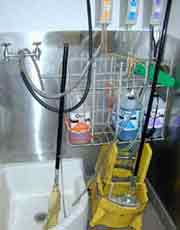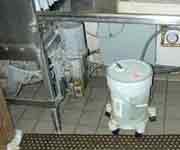|
|
Potential Hazard
Exposure of teen restaurant workers to
potentially hazardous chemicals such as oven
cleaners, floor cleaners, pesticides, disinfectants, drain
cleaners, soaps, detergents, and latex.
- Soaps and detergents may cause allergic reactions and
skin irritation.
- Broken skin from soap or detergent irritation may provide
an avenue for infection or injury if exposed to chemical
hazards.
- Drain cleaners, oven cleaners, and grill cleaners
solutions and sprays can be caustic and can cause skin burns
and eye and skin irritations.
- Ammonia, used as a cleaning agent, and
chlorine solutions, used as a disinfectant in dishwashing, can
cause skin, eye, and nose irritations. Caution: Mixing chlorine and ammonia solutions will result
in a chemical reaction and may release deadly chlorine gas.
- Latex gloves, worn to protect the hands from chemicals,
may cause skin irritation or allergic reactions in some teen
workers.
|

Cleaning Chemical Dispenser
|
|
|
Employers have the primary
responsibility for protecting the safety and health of their
workers. Employees are responsible for following the safe work
practices of their employers.
|
-
Read the product label and follow
instructions and recommendations listed on the label.
-
Use the least toxic cleaning products possible.
-
Use any personal protective
equipment provided by your employer such as gloves, eye
goggles, and special aprons.
- Be sure you are properly trained in the need
for and use of personal protective equipment.
-
Use appropriate gloves to
protect your hands from chemicals and sharp objects.
- After removing gloves,
wash your hands with mild soap and water, and dry thoroughly.
- Avoid latex gloves if you
have been diagnosed with latex allergy.
-
Ask your employer about possible toxic effects
of the chemicals you are required to use. You have the right to read
Material Safety Data Sheets
(MSDS) for
any chemicals you use. MSDS provide employers and
employees with information to protect themselves from
hazardous chemical exposures and to work safely with chemical
products.
-
Do not mix chlorine bleach and ammonia products together.
This combination will create a toxic gas.
|
|
|
Employers have the primary
responsibility for protecting the safety and health of their
workers. Employees are responsible for following the safe work
practices of their employers.
|
Follow OSHA Standards including:
-
If hazardous chemicals are used,
employers need to implement a written program that meets the
requirements of the Hazard
Communication Standard (HCS) to provide for worker
training, warning labels and access to Material
Safety Data Sheets (MSDS).
- The Hazard Communication Standard ensures employee awareness of the hazardous chemicals
they are exposed to in the workplace and how to prevent
exposure.
- Provide Material Safety Data Sheets for any hazardous chemicals that are used in
the workplace.
- Provide appropriate Personal Protective Equipment (PPE) such as, gloves, goggles, and splash aprons for employees who handle hazardous
chemicals including dishwashing detergents, pesticides, etc. [29
CFR 1910.132].
- Provide suitable facilities for quick drenching or
flushing of the eyes and body if exposure to injurious
corrosive material is possible. Facilities should be located
within the work area for immediate emergency use. Medical
Services and First Aid Standard [29
CFR 1910.151(c)].
|
|
Consider implementing recommended safe work practices, including:
|
-
Use
cleaning chemicals that are not considered hazardous.
-
Consider automating the dispensing of cleaning chemicals
whenever possible to avoid employee contact with chemicals.
-
Limit employee contact with dishwashing
detergents by providing dishwashing machines with automated
detergent dispensers.
-
Workers must still be cautious and use
appropriate PPE such as goggles and gloves when
changing out detergent containers.
|

Automated dishwashing detergent dispenser |
-
Ensure that chemicals that are not
compatible with each other are not stored together (check
MSDS).
-
Always label cleaning bottles and containers.
Never remove products from the original bottle without properly
labeling the new container.
-
Store pesticides in their original
labeled container.
-
Avoid storing liquid chemicals on top
shelves. Store them on lower shelves.
|

Always label cleaning products |
Additional Resources
Accessibility Assistance: Contact the OSHA Directorate of Science, Technology and Medicine at 202-693-2300 for assistance accessing OSHA PDF materials.
|
|

